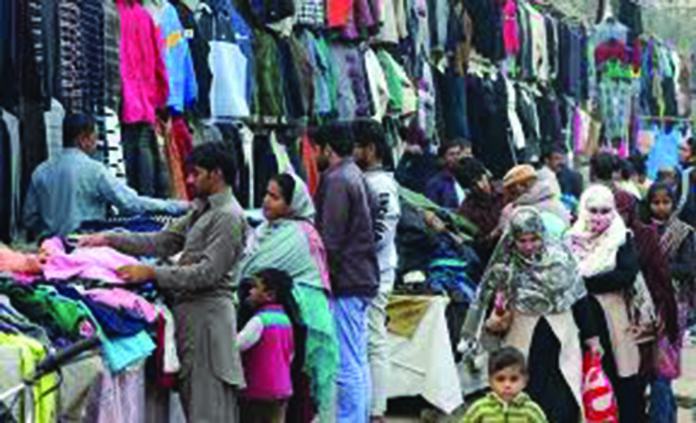By: Nisma Riaz
The landa bazaar, or as we call it here in Karachi, Sunday bazaar, is not for the faint of heart. If you can’t weaponize your elbows to make your way into the market, you will be left behind panting and hyperventilating. But amidst this chaos, overwhelming enough to make a grown man cry, is a sea of tables, stalls and sections scattered with all things imaginable to man, from clothes, shoes, jewelry and makeup to curtains, rugs, crockery and even appliances.
On the other side of Clifton, near Teen Talwar, a similar commotion is seen outside small shops displaying mini dresses, skirts, sparkly party tops, swimsuits, bralettes and all manner of other clothes. This is Karachi Playhouse, a market of preloved clothes and accessories and the ultimate goldmine for a party girl’s dream wardrobe.
And somewhere in the middle of these two markets, hovering above the sea and the city, stands Dolmen Mall Clifton. Exactly 23 steps into the mall and you’re greeted by Lama, a high-street, multi-fashion brand that claims to combine functional design with popular fashion: a Zara inspired outlet that has grown significantly over most major cities in the country. A smaller but quite similar group of women are seen strolling through the store, lazily sifting through the racks, sometimes stopping to feel the soft linen fabric between three fingers and turning over collars to eye the price tags dangling by a black thread.
And those who aren’t seen at any of these scenes, are sitting at home, scrolling incessantly on their phones, jumping from one online thrift shop to another Instagram thrift page.
But who are these women, hurriedly making their way through these markets, unstoppable unless something catches their keen eye? These are women, who otherwise wouldn’t be caught dead walking on the streets of Karachi, out in search of new clothes and determined to crush anyone who comes in their way. These same women are also master hagglers, trained by none other than their expert haggler mothers.
This is a story about buying a particular kind of clothing in Pakistan. We are talking about Western clothing, particularly for women. Over time, especially over the past decade, locally manufactured western clothing options for women have grown in Pakistan. They have grown because the demand for them has increased ever since women have become a larger part of the workforce. But the outlets manufacturing these clothes have restrictions. By their own accounts, they often have to self-censor the kind of clothes they produce and put on sale out of the fear of moral outrage. Yes, many players try to push boundaries, but they are aware of the delicate disposition of most mobs. That means while they do not make tube tops, and tank tops, and halter tops, and shorts, and mini bodycon dresses, and miniskirts, and the list goes on.
That does not mean you cannot find them in Pakistan. Despite the vague restrictions on women’s clothing in Pakistan, there is still an appetite for Western fashion; even the so-called “haram”, “skimpy” and “inappropriate” kind.
Against all odds, the landa bazaar has become the major hub for these clothes. More importantly, there is a growing trend of young, enterprising women with a keen eye for clothes going to the landa, finding the best products there, bringing them home and selling them at a profit on Instagram. These women often wash, model, photograph, market, and ship these clothes themselves out of college dorm rooms. Pages specialise in all kinds of things from clothes, to shoes, to intimates, to t-shirts, accessories, and yes, clothes you would not otherwise find in a store in Pakistan. Access to all kinds of clothing has never been easier. It means you no longer have to go on a trip or beg your cousin in the UK to bring you these things.
READ MORE: Online landa – the Instagram ‘thrift store’ arbitrage
Whether these clothes are being worn at a party, to work, at home, or on a trip abroad they are inching their way into the mainstream. What was once reserved for the underground is now creeping into the public eye, challenging sartorial boundaries one crop top at a time.
With global fast fashion giants like Zara, H&M, and Forever 21, considered budget-friendly abroad, remain out of reach for most Pakistanis, thanks to punishing exchange rates and a lack of local stores, and local brands trying to balance what is and isn’t socially permissible, this alternative ecosystem is thriving.
Profit explores Pakistan’s evolving fashion landscape, mapping out the formal and informal sectors shaping the industry. From locally produced ‘quiet luxury’ pieces to the underground thrift market keeping rebellious wardrobes alive, we take a closer look at where the demand for Western and ‘immodest’ fashion is coming from and just how far brands are willing to push the envelope before hitting a cultural wall.
The article is an excerpt from this week’s issue of Profit. For the full story, please visit Profit’s website.
The writer is a freelance columnist





















